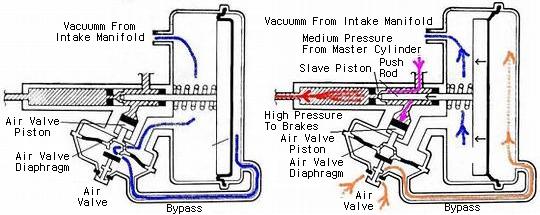The MGA With An Attitude
POWER BOOSTER, Remote, HOW IT WORKS - BT-201K
When you start the car, vacuum enters the booster and is applied equally to both sides of the servo main diaphragm, holding it in balance. A spring holds the main diaphragm in the rest position.
When you depress the brake pedal the master cylinder adds (medium) hydraulic pressure to the system. That pressure moves the air valve piston in the servo which does two things. It closes the internal vacuum port and opens another port to atmospheric air pressure. This allows the loss of vacuum and application of air pressure on far side of the diaphragm forcing the servo pushrod forward. This immediately closes a small bleed port in the servo piston, separating medium and high pressure hydraulic chambers, and pushes the servo piston forward to create high hydraulic pressure to operate the hydraulic brakes.

While you are holding the pedal down, modulating foot force on the pedal will modulate master cylinder pressure (medium hydraulic pressure), which in turn modulates the air valve to control the high hydraulic pressure output proportionally to pedal force.
When you release the brake pedal the atmospheric air valve closes, and the internal vacuum valve opens to equalize vacuum (absolute pressure) on both sides of the main diaphragm. The internal spring then returns the main diaphragm back to the original rest position, releasing output hydraulic pressure and re-opening the small port in the servo piston between high pressure and medium pressure chambers.
If the vacuum fails (leaks or engine stops), then hydraulic pressure from the master cylinder will move fluid through the small port in the servo piston to apply hydraulic pressure directly to the output port resulting in return to manual hydraulic brake operation (no power assist).
The small port in the servo piston connecting the medium and high pressure hydraulic chambers allows initial fluid filling in the system and bleeding to remove air from the circuits. It also allows fluid to move forward to compensate for disc brake caliper piston displacement as the brake pads wear. Pushing caliper pistons back to install new brake pads moves fluid back through the servo piston port to return to the master cylinder reservoir.
Concentric location of the servo piston bleed port and the output port requires the output end of the servo to be angled upward to allow escape of air when bleeding the brakes. Location of the servo air valve piston requires the air valve assembly to be positioned downward to allow removal of air from the air valve piston internal port.
As a questionable oddity, if you rest your foot gently on the brake pedal before starting the engine, when the engine starts and vacuum rises you may notice the brake pedal drop slightly. This is a normal function of the brake booster, and is not a problem (but it may be more pronounced if drum brake shoes are out of adjustment).
|